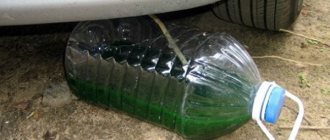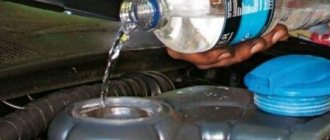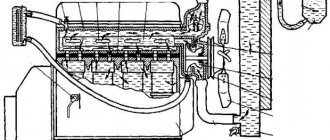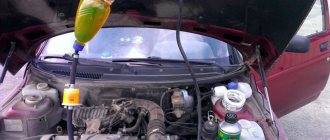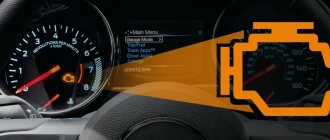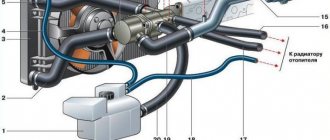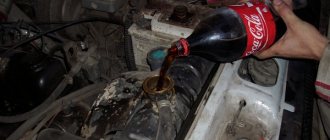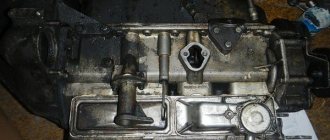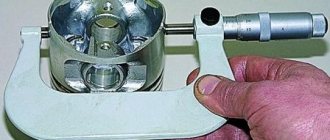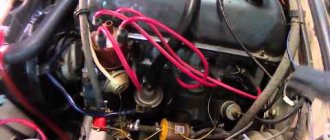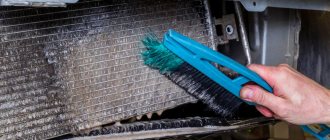When to flush
During operation, the radiator of the cooling system may become clogged. Moreover, it comes from the outside and from the inside. Today, manufacturers are trying to use higher quality materials, but even they do not protect against corrosion and scale.
If the antifreeze used is not replaced in time, it can also negatively affect the condition of the unit. A complex of such phenomena leads to the cooling system becoming dirty and in need of urgent cleaning.
It is not difficult to determine contamination of CO (cooling system) by a constantly overheating engine, regardless of weather conditions.
The frequency of flushing directly depends on operating conditions, engine condition, CO components used, etc.
1449660639_2279_4_9a_01zh
We unscrew the plug and drain the coolant from the cylinder block.
We tighten the drain plugs of the radiator and cylinder block. The connection between the plug and the cylinder block uses a conical thread that does not require additional sealing. Tighten the drain plug of the cylinder block to a torque of 25–30 Nm. We pour the fluid recommended by the manufacturer into the engine cooling system through the expansion tank until it is full. Let's start the engine. With the engine running, vigorously compress all the hoses of the cooling system several times in turn - this will help the fluid fill the system and displace air from it. As the coolant level in the expansion tank drops, bring it to normal and screw on the tank cap. When the engine warms up, the outlet (lower) radiator hose should be cold for some time, and then quickly heat up, which will indicate the beginning of fluid circulation in a large circle. After waiting for the cooling system fan to turn on, stop the engine. After the engine has cooled, check the coolant level again and, if necessary, replenish the system.
How to flush the cooling system on a VAZ 2110-2111-2112 yourself
Category: Do-it-yourself repairs - “How to flush the cooling system on a VAZ 2110-2111-2112 yourself”
Over time, various deposits are created in the engine cooling system, which is a consequence of the use of low-quality
Coolant (coolant). This leads to contamination of the channels, and in general to disruption of fluid circulation throughout the cooling system. As a result, the engine starts to heat up, the heater doesn’t heat up, etc. This photo report is dedicated to self-flushing the cooling system on VAZ 2110-2111-2112 cars
To clean the cooling system, you need to drain the liquid and fill it with distilled water with a special additive, for example Hi-Gear.
Then let the engine run for a while and drain
water along with dirt and sediment.
To completely flush the engine cooling system. need to:
- Flush the radiator. To do this, drain the coolant system, then disconnect the hoses from the base and upper radiator tank. Insert a garden hose into the top hose of the radiator and run water through the radiator until water comes out clean from the hose at the base of the radiator.
- Flush the engine. Insert a garden hose into the thermostat outlet and run water through the motor until water comes out clean from the bottom hose.
- Flush the heater core. Open the heater tap and disconnect the hoses from the heater. Connect a hose to one of the fittings and rinse with a stream of clean water until water flows out clean from the other fitting.
And now about how to properly drain and fill coolant into a VAZ 2110-2111-2112 engine
WARNING Replace coolant only when the engine is cold. Coolant is toxic, so be careful when handling it. When starting the engine, the expansion tank cap must be closed.
We install the car on a horizontal surface, preferably. so that the front is slightly higher than the rear. Disconnect the ground from the battery (On VAZ-2110.2112 engines the plug on the cylinder block is easily accessible, but to access it on the VAZ-2111 engine you will need to remove the ignition module.)
Now let's start draining the coolant.
Opening the expansion tank cap
Having placed the container under the engine, unscrew the drain plug on the cylinder block
After the liquid stops flowing, unscrew the drain plug on the radiator from the bottom, also first placing a container to drain the coolant.
How to wash the ENGINE COOLING system?
After the coolant is completely drained, screw all the plugs back in.
To prevent air locks from forming as the system is filled with coolant (the coolant will not completely fill the system), you should:
- If you have an injection engine, then loosen the clamp and disconnect the coolant supply hose from the throttle pipe heating fitting.
- If the engine is carburetor, then disconnect the hose from the carburetor heating fitting.
We begin to fill the engine cooling system through the expansion tank until its level is at the upper edge of the expansion tank mounting belt. Close the expansion tank cap.
Reconnect the hose to the throttle body or carburetor heater fitting (depending on engine model). Reinstall the ignition module and negative battery cable.
Start the engine and let it warm up to operating temperature (before turning on the fan). After this, turn off the engine, check the coolant level, and if necessary, add it to the same level.
When the engine is running, monitor the coolant temperature according to the gauge.
.
If the arrow has moved to the red zone
. and the fan does not turn on, turn on the heater and check what kind of air flows through it:
- If the air is warm/hot, the fan is most likely faulty.
- If it’s cold, then it’s all due to an air lock in the engine cooling system.
READ How many wheels are on a VAZ 2112
Getting rid of the air lock in the cooling system of VAZ 2110-2111-2112
You can remove the air lock by driving the front wheels onto a hill and letting the engine run at medium speed for a couple of minutes. If this does not help, then use the following instructions:
- Disconnect the pipe from the remote control (throttle assembly) going to the return line.
- Pour coolant into the reservoir.
- Coolant should flow from the remote control fitting (throttle assembly pipe). If you run, then go straight to point 6.
- We start it and close the hose with our finger.
- We are waiting for the coolant to run from the remote control.
- Plug the fitting when coolant flows and hold until coolant flows from the hose.
- As soon as it runs, we put the pipe back on (loops it).
- We warm up the internal combustion engine to operating temperatures and check the stove at idle.
- If the air blows hot, that means everything, if it’s warm, then we return to 1.
- Add coolant to normal level.
How to remove an air lock in the engine cooling system
You can remove the air lock by driving the front wheels onto a hill and letting the engine run at medium speed for a couple of minutes. If this does not help, then use the following instructions:
- Disconnect the pipe from the remote control (throttle unit) going to the saxophone (return).
- Pour coolant into the reservoir.
- Coolant should flow from the remote control fitting (throttle assembly pipe). If you run, then go straight to point 6.
- We start it and close the hose with our finger.
- We are waiting for the coolant to run from the remote control.
- Plug the fitting when coolant flows and hold until coolant flows from the hose.
- As soon as it runs, we put the pipe back on (loops it).
- We warm up the internal combustion engine to operating temperatures and check the stove at idle.
- If the air blows hot, that means everything, if it’s warm, then we return to 1.
- Add coolant to normal level.
Causes of clogged engine cooling system
The working coolant has a tendency to “boil over”. Antifreeze, distilled water or antifreeze circulates in the system - these are working coolers, which are monitored by marks in the tank and periodically topped up. Overheating and boiling over leads to loss of coolant properties and the formation of deposits in pipelines and on the internal walls of the radiator.
You can learn how to replace the coolant from our specialist’s detailed material.
We recommend that you additionally read our expert’s article, in which he talks about how to remove air from the engine cooling system.
Possible causes of clogging:
- dust and mechanical inclusions;
- chemical deposits;
- formation of salts (when adding regular water);
- corrosion of the material of the internal elements of CO with precipitation into a clogging sediment.
Changes in color and smell are signals to replace the distillate. If the consistency changes, foreign particles appear, or a contaminated emulsion forms, you must immediately use means to flush the engine cooling system.
Do-it-yourself or professional washing
Today, flushing the VAZ 2110 engine cooling system can be done in two ways.
- On one's own. This saves money significantly, but takes time, effort and nerves.
- With the help of auto repair shops. You don’t have to waste precious time, but the service costs money.
Each option has its own strengths and weaknesses. If you still prefer to wash it yourself, it is not enough for you to have a garage and tools at your disposal. First, study the nuances of the operation, read the instruction manual for your car, study the coolants used, etc.
Distilled water
Despite everything, distilled water continues to be actively used when flushing the engine cooling system. It is difficult to explain the reasons for its popularity, since this product is not highly effective.
Flushing the radiator with distilled water
The procedure for flushing CO using distilled water is as follows:
- The old coolant is drained;
- Distilled water is poured into the system;
- The engine starts and sits with the engine running for 10, maximum 15 minutes;
- The engine is turned off, after which the distilled water is drained;
- The procedure is repeated until clean water comes out of the system.
Acid, soda, vinegar
This is a more stringent method of flushing the system when compared to using distilled water. However, the level of efficiency is significantly higher.
VAZ 2110,11,12 the most effective way to flush the cooling system before replacing antifreeze
Cleaning OS with serum
To perform the flushing procedure, you will need:
- Prepare an appropriate solution, which includes caustic soda, lactic acid and vinegar. This mixture is poured into the cooling system. Just do not add too much lactic acid, as this is an aggressive agent that destroys the rubber elements of the CO;
- Then the system simply sits with the acidic liquid inside for no more than 8 hours. Ideally, it should stand for about 6 hours;
- During this period of time, the engine periodically starts and runs for a short time;
- When the specified time has elapsed, drain the acid solution, add distilled water and perform a procedure similar to the first washing method, where only water was used;
- 1-2 rinsing cycles with distilled water will be
- enough to remove all remaining acid solution;
- After this, all that remains is to fill in a new portion of antifreeze.
The main disadvantage is the danger of the solution itself, both to humans and to the internal components of the cooling system. Be sure to use protective equipment.
Features of the cooling system cleaning procedure
How to prevent malfunctions in the cooling system?
To do this, you must follow only 3 rules:
- You should always carefully monitor the color of the antifreeze when it is drained. If it has a dark tint, this indicates the presence of contamination in the system.
- Under no circumstances should you overuse partial addition of cooling fluid. The best solution would be to completely replace the used fluid. This will reduce the likelihood of any problem occurring.
- One portion of antifreeze should not be used for more than 2 years.
The color of the antifreeze hints at the need for replacement
How to flush the cooling system of a VAZ 2110
Specialized cleaning compounds
Get ready to spend a significant amount of money on them.
Specialized products are divided into four types:
- Neutral;
- Acidic;
- Two-component;
- Alkaline.
- Alkaline and acidic are considered the most popular because they demonstrate a high level of efficiency, plus from a financial point of view they turned out to be quite attractive.
- Two-component formulations include two main active elements - alkali and acid. They are offered in separate containers, the contents of which are poured into CO one at a time. This allows you to achieve excellent results and forget about a clogged cooling system and an overheated engine for a long time.
- Neutral products do not contain aggressive components. They serve for prevention, since there is no real effectiveness for strong cleaning.
READ How to adjust the ignition on a VAZ 2107 carburetor
All specialized cleaning agents are highly effective, except neutral ones. The components they contain cope with dirt, organic accumulations, fats, scale, etc. But they are expensive.
Coca-Cola is coming to us!
Do you think the cooling system cannot be flushed with carbonated water? It turns out that it is possible, and how! Coca-Cola is perfect for this purpose, especially on domestic cars. Surprisingly, even experienced car enthusiasts do this and it does not lead to any bad consequences.
The algorithm is similar to the previous one, with the difference that the operating time of the motor “under cola” can be reduced and nothing needs to be diluted in water. Well, before pouring soda into the system, it must be “degassed”, that is, wait until the carbon dioxide leaves it. Afterwards it is quite possible to fill in fresh coolant.
Distilled water
Despite everything, distilled water continues to be actively used when flushing the engine cooling system. It is difficult to explain the reasons for its popularity, since this product is not highly effective.
Flushing the radiator with distilled water
The procedure for flushing CO using distilled water is as follows:
- The old coolant is drained;
- Distilled water is poured into the system;
- The engine starts and sits with the engine running for 10, maximum 15 minutes;
- The engine is turned off, after which the distilled water is drained;
- The procedure is repeated until clean water comes out of the system.
First up is distilled water.
This product is famous and popular. It is not clear why, since it does not stand out for its highest efficiency.
First, drain the old coolant. Next, pour distilled water into the system. We start the engine. We let him work for 10-15 minutes and turn off the engine. And drain the distilled water from the system. The function will need to be repeated until the water becomes clear.
What may make this method so popular is most likely its ease of use. After all, you don’t need to put in much effort. Unfortunately, heavy stains cannot be removed this way. And besides, scale can form on the walls.
Cleaning agents and methods
To flush the engine cooling system on a VAZ 2110, you can use different means. All of them have a certain effectiveness and nuances of application.
These tools used today include:
- Distilled water;
- Soda, vinegar, acids;
- Specialized CO purification products.
Now let's figure out what is good or bad about each of the presented options.
The design of the cooling system on the VAZ 2110
The system of an 8-valve injector is very different from a 16-valve injector. On the 8-valve injector of the VAZ 2110, the system works with the help of cooling water that flows through this system.
Excess pressure occurs when the engine heats up, and then comes out through the exhaust valve. The 16-valve injector of the tenth system always contains the usual, normal temperature from 90 to 95 degrees Celsius, and the valve itself turns on at a pressure of 1.2 to 1.4 kgf/cm2.
VAZ 2110 engine cooling system: 1 – expansion tank plug; 2 – coolant level indicator sensor; 3 – expansion tank; 4 – outlet pipe; 5 – radiator outlet hose; 6 – radiator supply hose; 7 – steam removal hose; 8 – left radiator tank; 9 – sensor for turning on the electric fan; 10 – electric fan; 11 – electric fan impeller; 12 – radiator tubes; 13 – right radiator tank; 14 – radiator drain plug; 15 – electric fan casing; 16 – timing belt; 17 – toothed pulley of the coolant pump; 18 – coolant pump impeller; 19 – supply pipe of the coolant pump; 20 – hoses to the liquid chamber of the carburetor starting device; 21 – pipe for draining coolant from the heater radiator; 22 – hose for supplying fluid to the heater radiator; 23 – coolant temperature sensor; 24 – pump supply pipe hose; 25 – thermostat; 26 – filling hose.
With its increased pressure, the engine begins to return to its previous temperature, after which the intake valve is connected.
If there is a sudden failure to maintain the pressure, this can lead to overheating, which is what threatens the malfunction.
An electronic fan and thermostat maintain normal operating temperatures. Next, a signal is sent from the temperature sensor to the cooling system, and after that the system reduces the heating of the motor.
If the car has electric injection, then it has the ability to send a signal to the electrical control unit about overheating of the power unit. And during this time, with the support of the pump, liquid begins to succumb, which is distributed using the thermostat itself.
After connecting the motor, the thermostat needs to warm up to normal operating temperature. The thermostat drives the liquid through a small circle, and does not include circulation through the radiator.
READ How to properly grind valves on a VAZ 2106
Let's take a look at what the small circle actually includes:
- To warm up the car interior - a heater.
- Carburetor heating block.
- Intake manifold.
- And heating at the throttle unit.
If the engine has heated up to 90 degrees Celsius, then during this time the thermostat begins its work, driving a portion of the washing water to the radiator, and then when the sensor is triggered by engine overheating, all the liquid begins to spin in a larger circle.
Specialized cleaning compounds
Get ready to spend a significant amount of money on them.
Specialized products are divided into four types:
- Neutral;
- Acidic;
- Two-component;
- Alkaline.
- Alkaline and acidic are considered the most popular because they demonstrate a high level of efficiency, plus from a financial point of view they turned out to be quite attractive.
- Two-component formulations include two main active elements - alkali and acid. They are offered in separate containers, the contents of which are poured into CO one at a time. This allows you to achieve excellent results and forget about a clogged cooling system and an overheated engine for a long time.
- Neutral products do not contain aggressive components. They serve for prevention, since there is no real effectiveness for strong cleaning.
How to rinse SOD?
- Water.
- Water with vinegar and acid.
- Special liquid for flushing the cooling system.
Flushing the cooling system with water
Although it is possible to flush the system with water, I would strongly advise against it. As I already said, it contains a large amount of impurities and salts that form scale. If there is no other option, then at least use distilled water. Flushing the cooling system using distilled water is done as follows:
- Pour water into the SOD.
- Start the engine and let it run for about half an hour.
- Then turn off the engine and drain the water from the system. Repeat the procedure until your flushing fluid is the same as before flushing. The disadvantages of this method include: scale formation, low efficiency (boiling water is not able to dissolve and wash scale and other deposits).
Flushing the cooling system with water, acid and vinegar
Water with vinegar and acid is a little better than just water, because thanks to acids you can remove scale and partially clean the cooling system. In order to flush the system using this method, prepare: caustic soda, lactic acid and vinegar. The acid is added carefully and a little at a time; if you overdo it, you can say goodbye to the plastic and rubber parts of the cooling system. To completely remove scale and dirt, it takes 5-10 hours, during which it is necessary to periodically warm up the engine to operating temperature. At the end, all the liquid is drained and distillate is poured in, which is used for the final flushing of the cooling system.
Washing SOD using special chemicals
Specialist. means are the most effective and expensive option. However, the effectiveness of such a procedure is worth the overpayment. Cleaning products contain special cleaning agents that actively remove scale, grease, organic matter, etc.
Flushing specials products are divided into four types: acidic, alkaline, two-component, neutral.
Acid and alkaline are considered the least popular; moreover, they are almost impossible to find undiluted. This is explained by their aggressive effect on the entire cooling system, essentially plastic and rubber products.
Two-component products are very popular and in great demand. Their 2-component solution consisting of alkali and acid copes well with the task. Each of the components is poured into the radiator in turn.
Neutral cooling system cleaning products contain aggressive substances, such as acids or alkalis, and are used exclusively for preventive purposes.
Summing up
As you can see, there are quite a few ways and means to clean the cooling system and each of them has its own characteristics. If you do not want to spend money on expensive cleaning products, follow basic rules that will prevent the formation of plaque and scale. Namely:
- Fill only with high-quality antifreeze.
- Monitor its condition regularly and replace it on time.
- From time to time, wash the SOD using special. facilities.
That's all for me, thank you all for your attention and for visiting our vaz-remont.ru
When and why to flush
Solving this problem does not require special skills and knowledge, so you can flush the cooling system yourself. It is recommended to do this more often, but even if you perform cleaning once a year, you can achieve a positive effect.
Flushing allows you to avoid the occurrence of various malfunctions associated with the cooling system. The need for this procedure often arises due to the use of low-quality or expired antifreeze, which negatively affects the cooling unit of the car.
You can clean the cooling system less frequently if you adhere to the following rules for using antifreeze:
- When draining the coolant, you need to pay attention to its color, by which you can determine the degree of contamination of the system;
- instead of partially adding antifreeze, it is always better to completely replace it;
- The coolant must be renewed at least every two years.
We flush the cooling system with our own hands
It is advisable to carry out washing at least once a year. This is guaranteed to save us from problems with engine overheating.
We change old antifreeze of unknown color without hesitation.
Naturally, it is advisable to replace the antifreeze during the washing process. However, if the antifreeze is fresh and clean, this is not necessary. In this case, when draining the liquid, place clean containers under the radiator tap and the cylinder block plug.
- After draining the antifreeze, tighten the drain valves and plugs in accordance with the flushing manufacturer’s recommendations, fill the system with the mixture and warm up the engine to operating temperature or wait until the radiator fan turns on.
- We drain the flush and assess its condition.
If after the first time a cloudy liquid comes out of the system, repeat the process with a new portion of flushing.
We finish this “water procedure” when clear water flows.
Fill with antifreeze and tighten the reservoir cap.
When the engine has cooled down, check the antifreeze level in the expansion tank.
Simple cleaning products
Almost every owner has distilled water available. It is quite suitable for cleaning the system from simple contaminants. The water washing process is carried out in the following order:
- Drain the coolant and fill the system with water.
- Start the engine, which should run for 30 minutes.
- Drain remaining water.
These steps must be repeated until the water is clear when drained. This method will not help get rid of contaminants such as scale or rust.
You can also use lactic acid, caustic soda or vinegar to flush the cooling system. These products need to be mixed with distilled water, and then the same steps described above are performed. There should not be too much acid, otherwise such a solution can damage the rubber and plastic elements of the car. At the end of the procedure, you need to fill in clean distilled water, which is necessary to clean the system of residual solution.
When is it necessary to flush the engine cooling system?
Contamination of the technical channels of the internal combustion engine is indicated by the constant operation of the fan on the cooling radiator and malfunctions of the heating system. The problem must be resolved as soon as possible. You can do this yourself.
A number of signs indicate the need to flush the engine cooling system:
- regular overheating and problems with subsequent startup of the power unit;
- slow response to the rheostat signal;
- high readings of the coolant temperature sensor after starting the engine;
- pump operation with constant interruptions;
- change in the color of the coolant in the tank.
If such symptoms occur, it is necessary to immediately change the fluid for flushing the engine cooling system.
Special cleaning products
There are special products designed for flushing the cooling system. They are quite expensive, but this is compensated by their high efficiency. Such products contain components that can cope with organic matter, grease, scale and rust. Special means are of the following types:
- neutral. They do not contain aggressive substances, therefore they are mainly used for preventive purposes;
- two-component. The most optimal and popular option for cleaning the cooling system. These products do their job perfectly;
- acidic and alkaline. Most often they are found in diluted form, because they have the most aggressive effect.
Store-bought products for flushing the engine cooling system
Automotive stores offer a large selection of modern chemicals for cleaning the cooling system. Modern drugs are produced, which can be based not only on acidic or alkaline compounds, but also on neutral ones. Two-component products are also available. Most products are available in the form of special additives for antifreeze. The most popular auto chemicals of this type are:
- Hi-Gear Radiator Flush – 7 minute is produced by an American company. The composition does not contain aggressive acids, which avoids subsequent neutralization of the treated channels. After cleaning, the performance of the radiator increases to 50%. Processing time – no more than 7 minutes.
- LAVR Radiator Flush Classic - used in any car. It is highly effective, increasing the life of the pump, cleaning the thermostat and prolonging the operation of antifreeze by 40%.
- Bizol Kuhlerreiniger - designed to remove all contaminants. The advantage of the product is its maximum neutrality towards plastic, rubber and other non-metallic elements.
If in doubt, you can contact professionals who will perform the processing for an additional fee.
